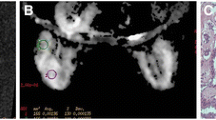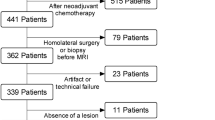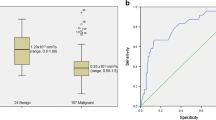Abstract
The purpose of this study was to investigate the diagnostic value of the apparent diffusion coefficient (ADC), measured by diffusion-weighted magnetic resonance imaging (MRI), for the diagnosis of breast lesions presenting as mass and non-mass-like enhancement (NMLE). The breast MRI studies of 174 patients were reviewed retrospectively. A total of 188 histologically confirmed lesions were analyzed and classified into 127 mass enhancement (86 malignant and 41 benign) and 61 NMLE (42 malignant and 19 benign). The ADC values were measured using a spin-echo echo-planner-imaging (SE-EPI) sequence with b = 1,000 s/mm2. Diagnostic performance was evaluated using receiver operating characteristic (ROC) analysis. The mean ADC was 0.99 ± 0.22 × 10−3 mm2/s for invasive cancer, 1.23 ± 0.33 × 10−3 mm2/s for ductal carcinoma in situ (DCIS), and 1.52 ± 0.35 × 10−3 mm2/s for benign adenosis. The mean ADC of all NMLE lesions was 1.44 ± 0.41 × 10−3 mm2/s, which is higher than the mean ADC of all mass lesions, 1.12 ± 0.33 × 10−3 mm2/s. In the ROC analysis, the optimal cutoff ADC value for differentiating benign from malignant lesions was 1.05 × 10−3 mm2/s for mass lesions and 1.35 × 10−3 mm2/s for NMLE. In conclusion, ADC values can be used for the diagnosis of invasive and DCIS as well as benign tumors. The NMLE lesions tend to have higher ADC values than mass lesions; therefore, the morphological appearance of a lesion needs to be considered when using the ADC value for diagnosis.






Similar content being viewed by others
References
Guo Y, Cai YQ, Cai ZL, Gao YG, An NY, Ma L, et al. Differentiation of clinically benign and malignant breast lesions using diffusion-weighted imaging. J Magn Reson Imaging. 2002;16:172–8.
Yuan J, Mei CS, Panych LP, McDannold NJ, Madore B. Towards fast and accurate temperature mapping with proton resonance frequency-based MR thermometry. Quant Imaging Med Surg. 2012;2:21–32.
Cheng L, Li X. Breast Imaging Reporting and Data System (BI-RADS) of magnetics resonance imaging: breast mass. Gland Surg. 2012;1:62–74.
Ishikawa T, Shimizu D, Kito A, Ota I, Sasaki T, Tanabe M, et al. Breast cancer manifested by hematologic disorders. J Thorac Dis. 2012;4:650–4.
Cheng L, Li X. Breast magnetic resonance imaging: focus/foci. Gland Surg. 2012;1:136–8.
Winston GP. The physical and biological basis of quantitative parameters derived from diffusion MRI. Quant Imaging Med Surg. 2012;2:254–65.
Partridge SC, DeMartini WB, Kurland BF, Eby PR, White SW, Lehman CD. Quantitative diffusion-weighted imaging as an adjunct to conventional breast MRI for improved positive predictive value. AJR Am J Roentgenol. 2009;193:1716–22.
Ei Khouli RH, Jacobs MA, Mezban SD, Huang P, Kamel IR, Macura KJ, et al. Diffusion-weighted imaging improves the diagnostic accuracy of conventional 3.0-T breast MR imaging. Radiology. 2010;256:64–73.
Partridge SC, Demartini WB, Kurland BF, Eby PR, White SW, Lehman CD. Differential diagnosis of mammographically and clinically occult breast lesions on diffusion-weighted MRI. J Magn Reson Imaging. 2010;31:562–70.
Partridge SC, Mullins CD, Kurland BF, Allain MD, DeMartini WB, Eby PR, et al. Apparent diffusion coefficient values for discriminating benign and malignant breast MRI lesions: effects of lesion type and size. AJR Am J Roentgenol. 2010;194:1664–73.
Yabuuchi H, Matsuo Y, Okafuji T, Kamitani T, Soeda H, Setoguchi T, et al. Enhanced mass on contrast-enhanced breast MR imaging: lesion characterization using combination of dynamic contrast-enhanced and diffusion-weighted MR images. J Magn Reson Imaging. 2008;28:1157–65.
Yabuuchi H, Matsuo Y, Kamitani T, Setoguchi T, Okafuji T, Soeda H, et al. Non-mass-like enhancement on contrast-enhanced breast MR imaging: lesion characterization using combination of dynamic contrast-enhanced and diffusion-weighted MR images. Eur J Radiol. 2010;75:e126–32. doi:10.1016/j.ejrad.2009.09.013.
Kuroki-Suzuki S, Kuroki Y, Nasu K, Nawano S, Moriyama N, Okazaki M. Detecting breast cancer with non-contrast MR imaging: combining diffusion-weighted and STIR imaging. Magn Reson Med Sci. 2007;6:21–7.
Baltzer PA, Benndorf M, Dietzel M, Gajda M, Camara O, Kaiser WA. Sensitivity and specificity of unenhanced MR mammography (DWI combined with T2-weighted TSE imaging, ueMRM) for the differentiation of mass lesions. Eur Radiol. 2010;20:1101–10. doi:10.1007/s00330-009-1654-5.
Woodhams R, Matsunaga K, Iwabuchi K, Kan S, Hata H, Kuranami M, et al. Diffusion-weighted imaging of malignant breast tumors: the usefulness of apparent diffusion coefficient (ADC) value and ADC map for the detection of malignant breast tumors and evaluation of cancer extension. J Comput Assist Tomogr. 2005;29:644–9.
Yoshikawa MI, Ohsumi S, Sugata S, Kataoka M, Takashima S, Mochizuki T, et al. Relation between cancer cellularity and apparent diffusion coefficient values using diffusion-weighted magnetic resonance imaging in breast cancer. Radiat Med. 2008;26:222–6. doi:10.1007/s11604-007-0218-3.
Imamura T, Isomoto I, Sueyoshi E, Yano H, Uga T, Abe K, et al. Diagnostic performance of ADC for non-mass-like breast lesions on MR imaging. Magn Reson Med Sci. 2010;9:217–25.
Tozaki M, Fukuda K. High-spatial-resolution MRI of non-masslike breast lesions: interpretation model based on BI-RADS MRI descriptors. AJR Am J Roentgenol. 2006;187:330–7. doi:10.2214/AJR.05.0998.
Goto M, Ito H, Akazawa K, Kubota T, Kizu O, Yamada K, et al. Diagnosis of breast tumors by contrast-enhanced MR imaging: comparison between the diagnostic performance of dynamic enhancement patterns and morphologic features. J Magn Reson Imaging. 2007;25:104–12. doi:10.1002/jmri.20812.
Jansen SA, Fan X, Karczmar GS, Abe H, Schmidt RA, Giger M, et al. DCEMRI of breast lesions: is kinetic analysis equally effective for both mass and nonmass-like enhancement. Med Phys. 2008;35:3102–9. doi:10.1118/1.2936220.
Newell D, Nie K, Chen JH, Hsu CC, Yu HJ, Nalcioglu O, et al. Selection of diagnostic features on breast MRI to differentiate between malignant and benign lesions using computer-aided diagnosis: differences in lesions presenting as mass and non-mass-like enhancement. Eur Radiol. 2010;20:771–81. doi:10.1007/s00330-009-1616-y.
Lehman CD. Magnetic resonance imaging in the evaluation of ductal carcinoma in situ. J Natl Cancer Inst Monogr. 2010;2010(41):150–1. doi:10.1093/jncimonographs/lgq030.
Hatakenaka M, Soeda H, Yabuuchi H, Matsuo Y, Kamitani T, Oda Y, et al. Apparent diffusion coefficients of breast tumors: clinical application. Magn Reson Med Sci. 2008;7:23–9.
Abdel Razek AA, Gaballa G, Denewer A, Tawakol I. Diffusion weighted MR imaging of the breast. Acad Radiol. 2010;17:382–6. doi:10.1016/j.acra.2009.10.014.
Jin G, An N, Jacobs MA, Li K. The role of parallel diffusion-weighted imaging and apparent diffusion coefficient (ADC) map values for evaluating breast lesions: preliminary results. Acad Radiol. 2010;17:456–63. doi:10.1016/j.acra.2009.12.004.
Le Bihan D, Breton E, Lallemand D, Grenier P, Cabanis E, Laval-Jeantet M. MR imaging of intravoxel incoherent motions: application to diffusion and perfusion in neurologic disorders. Radiology. 1986;161:401–7.
Gururajan M, Posadas EM, Chung LW. Future perspectives of prostate cancer therapy. Transl Androl Urol. 2012;1:19–32.
Yuen S, Yamada K, Goto M, Nishida K, Takahata A, Nishimura T. Microperfusion-induced elevation of ADC is suppressed after contrast in breast carcinoma. J Magn Reson Imaging. 2009;29:1080–4.
Acknowledgment
This study was supported by National Natural Science Foundation of China (no. 81150011).
Conflicts of interest
None
Author information
Authors and Affiliations
Corresponding author
Rights and permissions
About this article
Cite this article
Cheng, L., Bai, Y., Zhang, J. et al. Optimization of apparent diffusion coefficient measured by diffusion-weighted MRI for diagnosis of breast lesions presenting as mass and non-mass-like enhancement. Tumor Biol. 34, 1537–1545 (2013). https://doi.org/10.1007/s13277-013-0682-6
Received:
Accepted:
Published:
Issue Date:
DOI: https://doi.org/10.1007/s13277-013-0682-6




